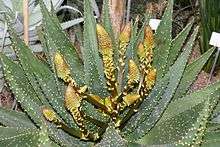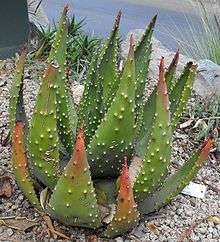Aloe aculeata
Aloe aculeata (common names include ngopanie, sekope, red hot poker aloe) is an Aloe species that is native to the Limpopo valley and Mpumalanga in South Africa along with southern and central Zimbabwe and Mozambique. It grows on rocky outcrops in grassland and dry bushveld.[1] Aculeata ("prickly") refers to the spines on the leaf's surface and the teeth on its margins.[2]
| Aloe aculeata | |
|---|---|
 | |
 | |
| Scientific classification | |
| Kingdom: | Plantae |
| Clade: | Tracheophytes |
| Clade: | Angiosperms |
| Clade: | Monocots |
| Order: | Asparagales |
| Family: | Asphodelaceae |
| Subfamily: | Asphodeloideae |
| Genus: | Aloe |
| Species: | A. aculeata |
| Binomial name | |
| Aloe aculeata Pole-Evans | |
The plant's leaves reach 30 to 60 cm (12 to 24 in) tall. Flowers are reddish orange to yellow when in bud, opening to orange to yellow, and 23 to 40 mm (0.91 to 1.57 in) long.[1][3]
Aloe aculeata was depicted on the reverse of the South African 10 cent coin from 1965-1989. The plant can be found in Gibraltar Botanic Gardens.[2]
References
- "Entry for Aloe aculeata (family ALOACEAE)". JSTOR Plant Science. Retrieved 4 September 2012.
- Alöe aculeata
- calflora.net Aloe aculeata Pole-Evans
External links
This article is issued from Wikipedia. The text is licensed under Creative Commons - Attribution - Sharealike. Additional terms may apply for the media files.